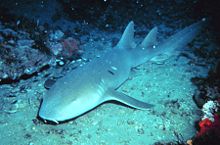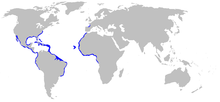| Nurse shark | |
|---|---|

| |
| Scientific classification | |
| Domain: | Eukaryota |
| Kingdom: | Animalia |
| Phylum: | Chordata |
| Class: | Chondrichthyes |
| Subclass: | Elasmobranchii |
| Order: | Orectolobiformes |
| Family: | Ginglymostomatidae |
| Genus: | Ginglymostoma |
| Species: | G. cirratum
|
| Binomial name | |
| Ginglymostoma cirratum (Bonnaterre, 1788)
| |

| |
| Range in blue | |
The nurse shark (Ginglymostoma cirratum) is an elasmobranch fish in the family Ginglymostomatidae. The conservation status of the nurse shark is globally assessed as Vulnerable in the IUCN List of Threatened Species.[2] They are considered to be a species of least concern in the United States and in The Bahamas, but considered to be near threatened in the western Atlantic Ocean because of their vulnerable status in South America and reported threats throughout many areas of Central America and the Caribbean.[2] They are directly targeted in some fisheries and considered by-catch in others.
Nurse sharks are an important species for shark research.[3] They are robust and able to tolerate capture, handling, and tagging extremely well.[4] As inoffensive as nurse sharks may appear, they are ranked fourth in documented shark bites on humans,[5] likely due to incautious behavior by divers on account of the nurse shark's calm, sedentary nature.
- ^ Sepkoski, J. (2002). "A compendium of fossil marine animal genera (Chondrichthyes entry)". Bulletins of American Paleontology. 364: 560.
- ^ a b c Carlson, J.; Charvet, P.; Blanco-Parra, MP; Briones Bell-lloch, A.; Cardenosa, D.; Derrick, D.; Espinoza, E.; Herman, K.; Morales-Saldaña, J.M.; Naranjo-Elizondo, B.; Pérez Jiménez, J.C.; Schneider, E.V.C.; Simpson, N.J.; Talwar, B.S.; Pollom, R.; Pacoureau, N.; Dulvy, N.K. (2021). "Ginglymostoma cirratum". IUCN Red List of Threatened Species. 2021: e.T144141186A3095153. doi:10.2305/IUCN.UK.2021-1.RLTS.T144141186A3095153.en. Retrieved 18 November 2021.
- ^ Osgood, G. J and J. K. Baum. (2015). "Reef sharks: recent advances in ecological understanding to inform conservation". Journal of Fisheries Biology. 87 (6): 1489–1523. Bibcode:2015JFBio..87.1489O. doi:10.1111/jfb.12839. PMID 26709218.
- ^ Aucoin, S.; Weege, S.; Toebee, M.; Guertin, J.; Gorham, J.; Bresette, M. (2017). "A new underwater shark capture method used by divers to catch and release nurse sharks (Ginglymostoma cirratum)". Fishery Bulletin. 115 (4): 484–495. doi:10.7755/FB.115.4.5.
- ^ Ricci, J. A.; Vargas, C. R.; Singhal, D.; Lee, B. T. (2016). "Shark attack-related injuries: epidemiology and implications for plastic surgeons". Journal of Plastic, Reconstructive & Aesthetic Surgery. 69 (1): 108–114. doi:10.1016/j.bjps.2015.08.029. PMID 26460789.
